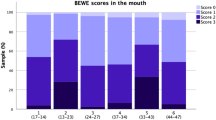Abstract
Background
Clinical photographs and study models may provide permanent records of dental erosion and be useful supplements to clinical registration.
Aim
To assess the reliability and validity of registrations on clinical photographs and study models performed by a group of examiners.
Methods
Thirty tooth surfaces were selected and assessed clinically, using the visual erosion dental examination system. The chosen surfaces provided the whole range of dental erosions including sound surfaces. The tooth surfaces were photographed and impressions were obtained for preparation of study models. Thirty-three dentists examined and scored the selected surfaces both on photographs and study models.
Results
The quality of diagnosis (AUC, area under curve) was slightly higher using photographs as compared to study models. The difference was statistically significant when the validation criterion was erosion, assuming dentine exposure. The inter-method agreement on photographs and study models versus the clinical evaluation were approximately in the same range with a mean κw of 0.48 and 0.43, respectively. When comparing study models with photographs the mean κw was 0.52. The intra-examiner agreement was strong/substantial for both (photographs mean κw = 0.63 and study models mean κw = 0.60).
Statistics
Linear weighted Cohen’s kappa (κw) was used to evaluate inter-method and intra-examiner agreement. Receiver operating characteristic and area under the curves were used to express diagnostic quality according to a clinical examination.
Conclusion
The results indicated that photographs were as good as study models for recording erosive lesions.



Similar content being viewed by others
References
Al-Malik MI, Holt RD, Bedi R. Clinical and photographic assessment of erosion in 2-5-year-old children in Saudi Arabia. Community Dent Health. 2001;18:232–5.
Arnadottir IB, Holbrook WP, Eggertsson H, et al. Prevalence of dental erosion in children: a national survey. Community Dent Oral Epidemiol. 2010;38:521–6.
Berg-Beckhoff G, Kutschmann M, Bardehle D. Methodological considerations concerning the development of oral dental erosion indexes: literature survey, validity and reliability. Clin Oral Investig. 2008;12(Suppl 1):S51–8.
El Aidi H, Bronkhorst EM, Truin GJ. A longitudinal study of tooth erosion in adolescents. J Dent Res. 2008;87:731–5.
Ganss C, Klimek J, Giese K. Dental erosion in children and adolescents—a cross-sectional and longitudinal investigation using study models. Community Dent Oral Epidemiol. 2001;29:264–71.
Ganss C, Lussi A. Diagnosis of erosive tooth wear. Monogr Oral Sci. 2006;20:32–43.
Ganss C, Klimek J, Lussi A. Accuracy and consistency of the visual diagnosis of exposed dentine on worn occlusal/incisal surfaces. Caries Res. 2006;40:208–12.
Hasselkvist A, Johansson A, Johansson AK. Dental erosion and soft drink consumption in Swedish children and adolescents and the development of a simplified erosion partial recording system. Swed Dent J. 2010;34:187–95.
Hintze H, Frydenberg M, Wenzel A. Influence of number of surfaces and observers on statistical power in a multiobserver ROC radiographic caries detection study. Caries Res. 2003;37:200–5.
Holbrook WP, Ganss C. Is diagnosing exposed dentine a suitable tool for grading erosive loss? Clin Oral Investig. 2008;12(Suppl 1):S33–9.
Jaeggi T, Lussi A. Prevalence, incidence and distribution of erosion. Monogr Oral Sci. 2006;20:44–65.
Johansson AK, Johansson A, Birkhed D, et al. Dental erosion associated with soft-drink consumption in young Saudi men. Acta Odontol Scand. 1997;55:390–7.
Kreulen CM, Van‘t SA, Rodriguez JM, et al. Systematic review of the prevalence of tooth wear in children and adolescents. Caries Res. 2010;44:151–159.
Landis JR, Koch GG. The measurement of observer agreement for categorical data. Biometrics. 1977;33:159–74.
Larsen IB, Westergaard J, Stoltze K, et al. A clinical index for evaluating and monitoring dental erosion. Community Dent Oral Epidemiol. 2000;28:211–7.
Larsen MJ, Poulsen S, Hansen I. Erosion of the teeth: prevalence and distribution in a group of Danish school children. Eur J Paediatr Dent. 2005;6:44–7.
Lussi A, Hellwig E. Risk assessment and preventive measures. Monogr Oral Sci. 2006;20:190–9.
Mulic A, Tveit AB, Hove LH, Skaare AB. Dental erosive wear among Norwegian wine tasters. Acta Odontol Scand. 2010a;69:21–6.
Mulic A, Tveit AB, Wang NJ, et al. Reliability of two clinical scoring systems for dental erosive wear. Caries Res. 2010b;44:294–9.
Nunn JH, Gordon PH, Morris AJ, Pine CM, Walker A. Dental erosion—changing prevalence? A review of British National childrens’ surveys. Int J Paediatr Dent. 2003;13:98–105.
van Rijkom HM, Truin GJ, Frencken JE, et al. Prevalence, distribution and background variables of smooth-bordered tooth wear in teenagers in the Hague, the Netherlands. Caries Res. 2002;36:147–54.
Author information
Authors and Affiliations
Corresponding author
Rights and permissions
About this article
Cite this article
Hove, L.H., Mulic, A., Tveit, A.B. et al. Registration of dental erosive wear on study models and intra-oral photographs. Eur Arch Paediatr Dent 14, 29–34 (2013). https://doi.org/10.1007/s40368-012-0004-5
Received:
Accepted:
Published:
Issue Date:
DOI: https://doi.org/10.1007/s40368-012-0004-5




